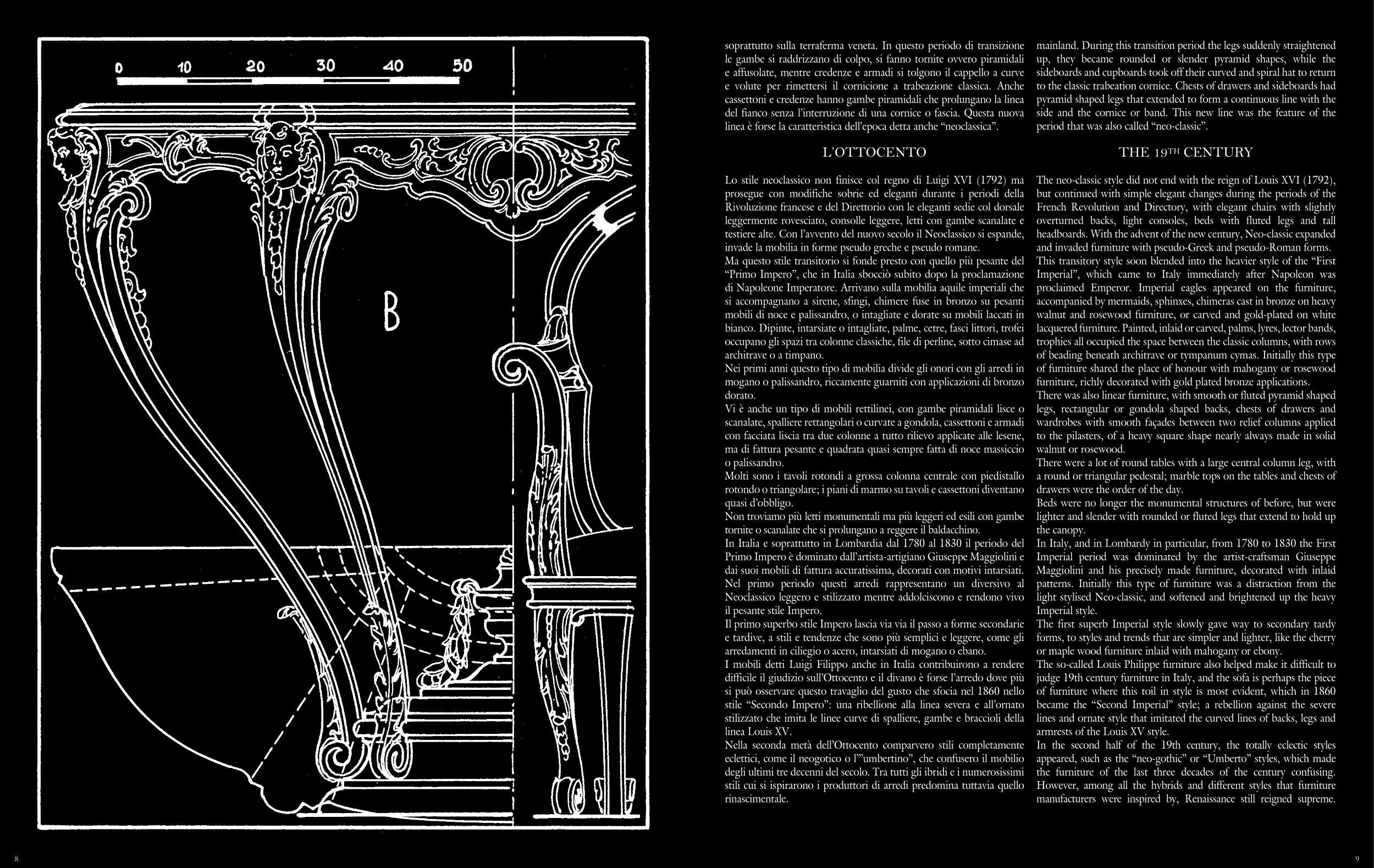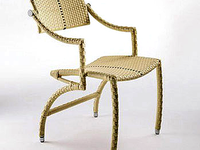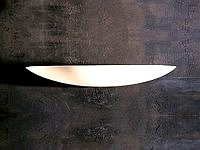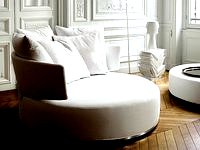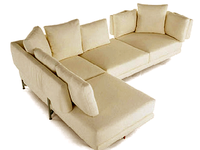soprattutto sulla terraferma veneta. In questo periodo di transizione
le gambe si raddrizzano di colpo, si fanno tornite ovvero piramidali
e affusolate, mentre credenze e armadi si tolgono il cappello a curve
e volute per rimettersi il cornicione a trabeazione classica. Anche
cassettoni e credenze hanno gambe piramidali che prolungano la linea
del fianco senza l’interruzione di una cornice o fascia. Questa nuova
linea è forse la caratteristica dell’epoca detta anche “neoclassica”.
L’OTTOCENTO
Lo stile neoclassico non finisce col regno di Luigi XVI (1792) ma
prosegue con modifiche sobrie ed eleganti durante i periodi della
Rivoluzione francese e del Direttorio con le eleganti sedie col dorsale
leggermente rovesciato, consolle leggere, letti con gambe scanalate e
testiere alte. Con l’avvento del nuovo secolo il Neoclassico si espande,
invade la mobilia in forme pseudo greche e pseudo romane.
Ma questo stile transitorio si fonde presto con quello più pesante del
“Primo Impero”, che in Italia sbocciò subito dopo la proclamazione
di Napoleone Imperatore. Arrivano sulla mobilia aquile imperiali che
si accompagnano a sirene, sfingi, chimere fuse in bronzo su pesanti
mobili di noce e palissandro, o intagliate e dorate su mobili laccati in
bianco. Dipinte, intarsiate o intagliate, palme, cetre, fasci littori, trofei
occupano gli spazi tra colonne classiche, file di perline, sotto cimase ad
architrave o a timpano.
Nei primi anni questo tipo di mobilia divide gli onori con gli arredi in
mogano o palissandro, riccamente guarniti con applicazioni di bronzo
dorato.
Vi è anche un tipo di mobili rettilinei, con gambe piramidali lisce o
scanalate, spalliere rettangolari o curvate a gondola, cassettoni e armadi
con facciata liscia tra due colonne a tutto rilievo applicate alle lesene,
ma di fattura pesante e quadrata quasi sempre fatta di noce massiccio
o palissandro.
Molti sono i tavoli rotondi a grossa colonna centrale con piedistallo
rotondo o triangolare; i piani di marmo su tavoli e cassettoni diventano
quasi d’obbligo.
Non troviamo più letti monumentali ma più leggeri ed esili con gambe
tornite o scanalate che si prolungano a reggere il baldacchino.
In Italia e soprattutto in Lombardia dal 1780 al 1830 il periodo del
Primo Impero è dominato dall’artista-artigiano Giuseppe Maggiolini e
dai suoi mobili di fattura accuratissima, decorati con motivi intarsiati.
Nel primo periodo questi arredi rappresentano un diversivo al
Neoclassico leggero e stilizzato mentre addolciscono e rendono vivo
il pesante stile Impero.
Il primo superbo stile Impero lascia via via il passo a forme secondarie
e tardive, a stili e tendenze che sono più semplici e leggere, come gli
arredamenti in ciliegio o acero, intarsiati di mogano o ebano.
I mobili detti Luigi Filippo anche in Italia contribuirono a rendere
difficile il giudizio sull’Ottocento e il divano è forse l’arredo dove più
si può osservare questo travaglio del gusto che sfocia nel 1860 nello
stile “Secondo Impero”: una ribellione alla linea severa e all’ornato
stilizzato che imita le linee curve di spalliere, gambe e braccioli della
linea Louis XV.
Nella seconda metà dell’Ottocento comparvero stili completamente
eclettici, come il neogotico o l’”umbertino”, che confusero il mobilio
degli ultimi tre decenni del secolo. Tra tutti gli ibridi e i numerosissimi
stili cui si ispirarono i produttori di arredi predomina tuttavia quello
rinascimentale.
mainland. During this transition period the legs suddenly straightened
up, they became rounded or slender pyramid shapes, while the
sideboards and cupboards took off their curved and spiral hat to return
to the classic trabeation cornice. Chests of drawers and sideboards had
pyramid shaped legs that extended to form a continuous line with the
side and the cornice or band. This new line was the feature of the
period that was also called “neo-classic”.
THE 19TH CENTURY
The neo-classic style did not end with the reign of Louis XVI (1792),
but continued with simple elegant changes during the periods of the
French Revolution and Directory, with elegant chairs with slightly
overturned backs, light consoles, beds with fluted legs and tall
headboards. With the advent of the new century, Neo-classic expanded
and invaded furniture with pseudo-Greek and pseudo-Roman forms.
This transitory style soon blended into the heavier style of the “First
Imperial”, which came to Italy immediately after Napoleon was
proclaimed Emperor. Imperial eagles appeared on the furniture,
accompanied by mermaids, sphinxes, chimeras cast in bronze on heavy
walnut and rosewood furniture, or carved and gold-plated on white
lacquered furniture. Painted, inlaid or carved, palms, lyres, lector bands,
trophies all occupied the space between the classic columns, with rows
of beading beneath architrave or tympanum cymas. Initially this type
of furniture shared the place of honour with mahogany or rosewood
furniture, richly decorated with gold plated bronze applications.
There was also linear furniture, with smooth or fluted pyramid shaped
legs, rectangular or gondola shaped backs, chests of drawers and
wardrobes with smooth façades between two relief columns applied
to the pilasters, of a heavy square shape nearly always made in solid
walnut or rosewood.
There were a lot of round tables with a large central column leg, with
a round or triangular pedestal; marble tops on the tables and chests of
drawers were the order of the day.
Beds were no longer the monumental structures of before, but were
lighter and slender with rounded or fluted legs that extend to hold up
the canopy.
In Italy, and in Lombardy in particular, from 1780 to 1830 the First
Imperial period was dominated by the artist-craftsman Giuseppe
Maggiolini and his precisely made furniture, decorated with inlaid
patterns. Initially this type of furniture was a distraction from the
light stylised Neo-classic, and softened and brightened up the heavy
Imperial style.
The first superb Imperial style slowly gave way to secondary tardy
forms, to styles and trends that are simpler and lighter, like the cherry
or maple wood furniture inlaid with mahogany or ebony.
The so-called Louis Philippe furniture also helped make it difficult to
judge 19th century furniture in Italy, and the sofa is perhaps the piece
of furniture where this toil in style is most evident, which in 1860
became the “Second Imperial” style; a rebellion against the severe
lines and ornate style that imitated the curved lines of backs, legs and
armrests of the Louis XV style.
In the second half of the 19th century, the totally eclectic styles
appeared, such as the “neo-gothic” or “Umberto” styles, which made
the furniture of the last three decades of the century confusing.
However, among all the hybrids and different styles that furniture
manufacturers were inspired by, Renaissance still reigned supreme.
9
8


